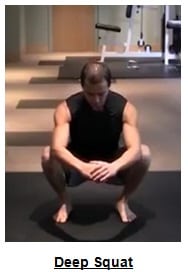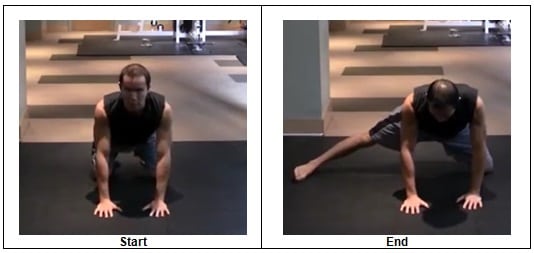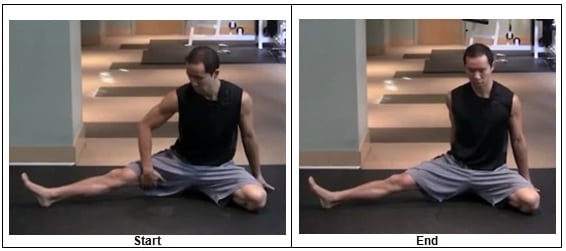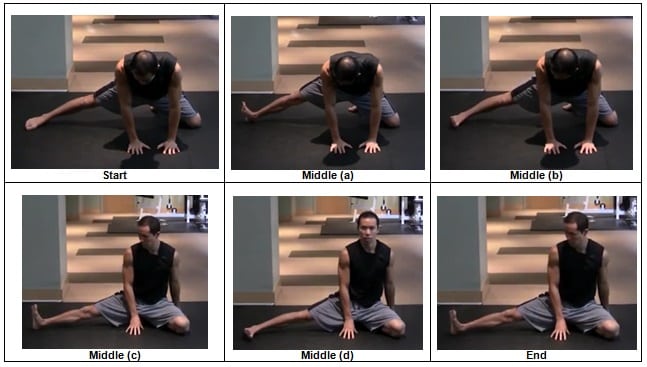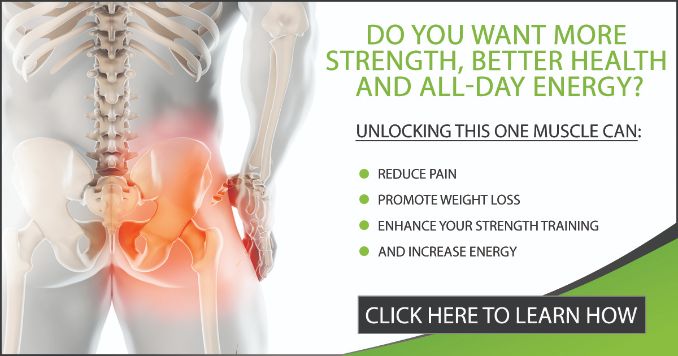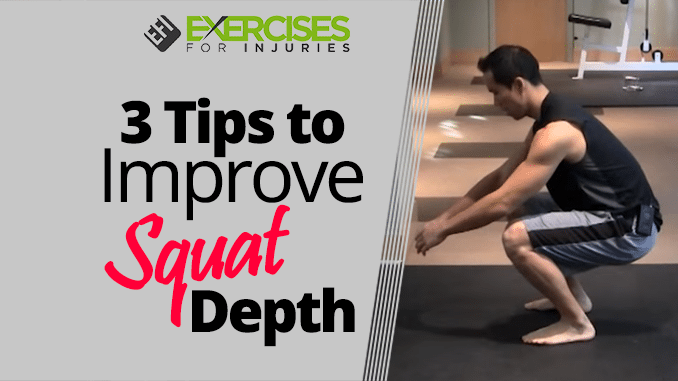
Squat Depth is a controversial topic in the strength and conditioning space. On the one hand, you have strength coaches who preach the importance of squat Depth to get faster acceleration out of the bottom position, increase hip drive and reduce the risk of patellar tendonitis by keeping your knees out. And on the other hand, you have performance coaches who preach keeping your squat Depth above parallel because it’s safer for your knees and will produce more force at faster speeds.
Hey! Eric Wong here. My friend Rick Kaselj asked me to do this video for his followers to give you some of the more advanced techniques that I have to help you get deeper into the squat. (If you want to loosen up your hips in the deadlift, check this post out.) What’s up, guys?
CLICK HERE to watch the YouTube video
I’m going to show you three different exercises, and I will explain the significance of these exercises and the techniques used. These, again, are more advanced techniques, but all you guys following Rick are more advanced people because you are learning from this guy, and he knows what he is talking about.
Tip 1. Contract Relax specifically for the adductors
The first one I will show you is Adductor Contract Relax Stretch.
If your groin is tight, your adductors, it’s going to be tough to get down deep into this squat properly because when you go into the squat, you’ve got to open up the hips.
You’re going to open those hips out and get the glutes involved; to do that, we need to loosen our adductors.
One exercise I love doing here is the Adductor Contract Relax Stretch.
We set up into a four-point stance here. Stick one foot out.
I like this four-point stance because you are already in hip flexion, so it’s like being at the bottom of the squat.
From there, ensure you keep a good posture in the lumbar spine. We always train ourselves into good posture. You just kind of crawl the foot out until you feel a stretch.
Adductor Contract Relax Stretch
You must focus on externally rotating the hips, turning the knee cap up, and keeping the knee a little bit bent. That will save you from putting too much stress on the ligaments in the knee, especially the medial collateral ligament and medial meniscus.
Once I’m in position, I’m going to push down. I push my foot down and also do the knee.
I am scissoring it together, so I am contracting the adductors on both sides for 5 seconds, breathing, relaxing, and then relaxing down. Then often, because of that, you can go a little bit deeper. You do that 2 or 3 times per leg, and that will not only strengthen and lengthen your adductors, but the result is it will also strengthen them at that range of motion.
Role of Strength
Without strength, flexibility is no good — because you can’t get into those ranges of motion and use that range of motions. The neuromuscular system tells the body, “Okay, I’ve got this length, but I can’t use it. I have no stability there.” I better tighten that muscles, so my joints don’t become unstable, and no injury will happen to my joints. So that’s Technique 1 – Contract Relax specifically for the adductors.
Tip 2. Avoid the Butt Wink
Now, what we can do as well, you probably heard of Butt Wink. When you squat, you get down, and the tail tucks under the lumbar spine flex. That’s dangerous, especially if you are squatting with any significant loads.
You have to keep that lumbar spine neutral when you’re at the bottom.
We can do a similar exercise but instead of this position, what I am going to do is I’m going to sit down. After I finish that one leg, stretching out the adductor and doing the last sequence there, I’m going to sit down. I will keep a good pull posture, knees a bit bent, still focusing on that external hip rotation. Keep the knee cap turned up so I don’t hyper-extend the knee, causing any joint laxity.
I will drive the heel to the ground and stretch with the hamstring. The hamstrings are often what is tight, causing the butt wink, which pulls the pelvis under (posterior tilt) and flattens out the lumbar spine. Do this for 5 seconds and then relax. I can pull that leg out, slide it out a little further, increase the stretch, and then do that again. Keep breathing. Keep good posture. Drop the hand back. Good posture, nice and tall, and then relax, so two or three contractors are the last sequences there.
Tip 3. Scour Your Muscles
I will show more of my super advanced secret techniques here, and it is what I call Scouring. It is super important for keeping that rotation ability of the hip joint.
The hip joint is a ball and socket built to do all types of movements, the rotation being one of them, and that’s often one of the movements we lose.
I’ve developed this technique specifically to help my athletes kick better because whenever you throw a side kick or roundhouse kick, you need that rotation in your hip joint. Still, it helps anybody who wants to squat deeper, deadlift better, and do any lower body exercises.
We can go in the first position or do both positions. From here, we just rotate that toe, keeping good posture and maintaining the lumbar spine. We go back and forth, and you do six repetitions there and then the same thing here. You can do it anywhere from 5 to 10 repetitions.
Scouring Position
What we are doing is called Scouring because it’s just like a scouring pad when you are cleaning dirty dishes. Food straight on, you’ve been lazy, and you have a plate full of leftovers on the counter for a couple of days, and now it’s all dry and crusty. That can happen to our hips when we sit all day and do not mobilize them in different positions and movements that we need. The rotation is one of them.
Scouring is like taking up steel wool and just getting in there and grinding the hip out, opening it up, cleaning up the joint and the joint caps.
Why is squat Depth important?
The squat is the king of all exercises because it’s an all-around movement that hits your entire lower body and core with everything you’ve got. It’s the best way to build strength, reduce your risk of injury, and improve your performance in any sport requiring explosive strength, speed, and power. It’s an essential exercise for powerlifters, strength coaches, serious athletes, and anyone trying to improve their overall health and fitness.
Squat Depth is important because it affects how the lift is executed and the overall benefits you’ll get from it. For example, if you’re not squatting below parallel, you’re reducing the amount of muscle you’re activating, and you’re missing out on the benefits associated with that range of motion.
Squat Depth and acceleration
One of the main arguments in favor of squatting below parallel is that it allows you to accelerate through the bottom of the lift. This is important because the faster you can accelerate the barbell, the more force you’ll be able to lift. This comes with several benefits, such as increased muscle activation, larger amounts of muscle fiber recruitment, increased power output, and improved rate of force development (RFD). These things will help you become stronger, faster, and more explosive in sports that require quick bursts of power, like American football, basketball, rugby, and hockey. Acceleration is also important for lifters trying to break personal records, improve their one-rep max or be more competitive globally.
Squat Depth and the risk of patellar tendonitis
Patellar tendonitis, also known as “jumper’s knee” or “patellar tendinosis,” is a common injury in athletes who perform repetitive movements, especially those who play sports that require quick bursts of power and speed. It is one of the most common knee injuries among athletes, especially basketball and volleyball players, and can be very painful. The patellar tendon is the tendon connecting your shin to your knee and assists with knee extension, which is why it’s important for jumping and squats.
Conclusion
Those are three of my powerful techniques for improving length and strength in the hip muscles and, improving your hip flexibility and mobility, cleaning up that joint capsule. It will help you a lot so start doing that up and spend 5 to 10 minutes just doing that sequence properly. Take your time with it; after a couple of weeks, you will find a huge benefit in your flexibility and strength in other exercises like squats and deadlifts. If you’re doing any sports, kicking, sprinting, or doing intervals, you can open up more and do better with those exercises and movements.
Do you have trouble touching your toes? Or do you feel like you can’t even get close to them? Either way, it’s probably because your hip flexibility is holding you back.
Fortunately, increasing your range of motion in that area isn’t as difficult as it seems. In fact, with a commitment of a few minutes per day for a few weeks and the right plan, we’re certain that you can improve the flexibility in your hips.
If this sounds like something that would be helpful to you, keep reading to learn more about different ways to increase hip flexibility and start working towards those toes again!
I’ll talk to you soon. See you.
Eric Wong
.

